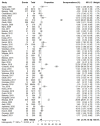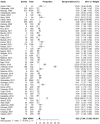The burden of Hepatitis B virus infection in Kenya: A systematic review and meta-analysis
- PMID: 36778557
- PMCID: PMC9909240
- DOI: 10.3389/fpubh.2023.986020
The burden of Hepatitis B virus infection in Kenya: A systematic review and meta-analysis
Abstract
Background: Chronic Hepatitis B virus (HBV) infection causes liver cirrhosis and cancer and is a major public health concern in Kenya. However, so far no systematic review and meta-analysis has been conducted to estimate the burden of disease in the country. A better understanding of HBV infection prevalence will help the government implement efficient strategies at eliminating the disease. This systematic review and meta-analysis was therefore conducted to summarize and update the available information on the burden of HBV in Kenya.
Method: We systematically searched PubMed, Science Direct, Web of Science, Scopus, African Journals OnLine, and Google Scholar databases to retrieve primary studies conducted between January 1990 and June 2021 that assessed the prevalence of HBV infection in Kenya based on measurement of the Hepatitis B Surface Antigen (HBsAg). Meta-analysis was performed using the random effects model where HBsAg prevalence was estimated at a 95% confidence interval (CI) after simple pooling analysis. Potential sources of heterogeneity were also investigated.
Results: Fifty studies were included in the meta-analysis with a sample size of 108448. The overall pooled prevalence estimate of HBV in Kenya was 7.8% (95% CI: 5.8-10.1). Subgroup analysis revealed the highest prevalence among patients presenting with jaundice at 41.7% (95% CI: 13.5-73.3) whereas blood donors had the lowest prevalence at 4.1% (95% CI: 2.4-6.3). Prevalence in Human Immunodeficiency Virus (HIV)-infected individuals was 8.2% (95% CI: 5.8-11.0). An estimate of the total variation between studies revealed substantial heterogeneity (I2 = 99%) which could be explained by the study type, the risk status of individuals, and the region of study.
Conclusion: We present the first systematic review and meta-analysis of the prevalence of HBV in Kenya. Our results show that the burden of HBV in Kenya is still enormous. This calls for an urgent need to implement public health intervention measures and strategic policies that will bring the disease under control and lead to final elimination.
Systematic review registration: https://www.crd.york.ac.uk/prospero/display_record.php?RecordID=264859, identifier: CRD42021264859.
Keywords: Hepatitis B virus; Kenya; meta-analysis; prevalence; review.
Copyright © 2023 Makokha, Zhang, Hayes, Songok and Chayama.
Conflict of interest statement
The authors declare that the research was conducted in the absence of any commercial or financial relationships that could be construed as a potential conflict of interest.
Figures





References
-
- Global health Sector Strategy on Viral Hepatitis 2016-2021 . Towards Ending Viral Hepatitis. (2022). Available online at: https://www.who.int/publications/i/item/WHO-HIV-2016.06 (Accessed June 9, 2022).
Publication types
MeSH terms
Substances
LinkOut - more resources
Full Text Sources
Medical

